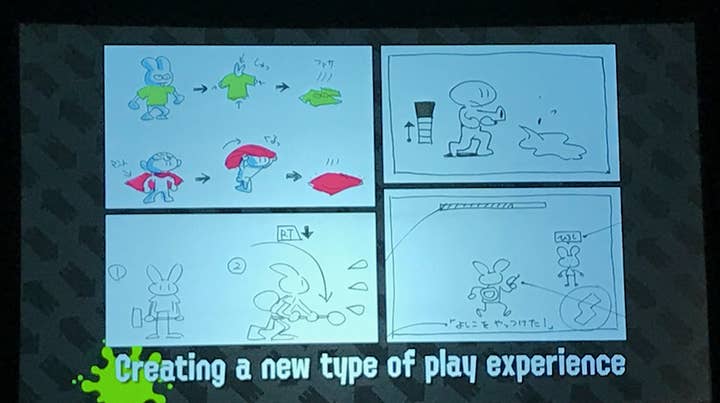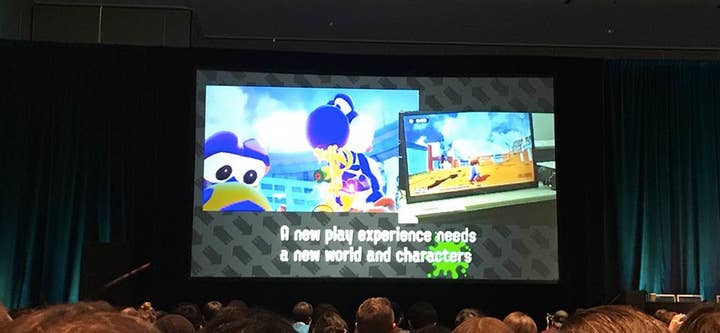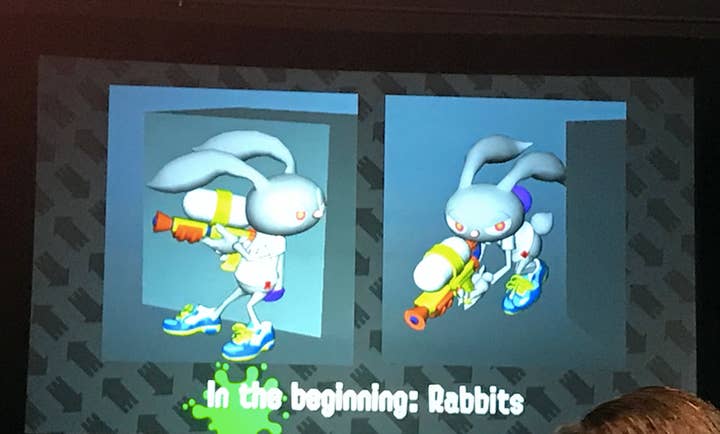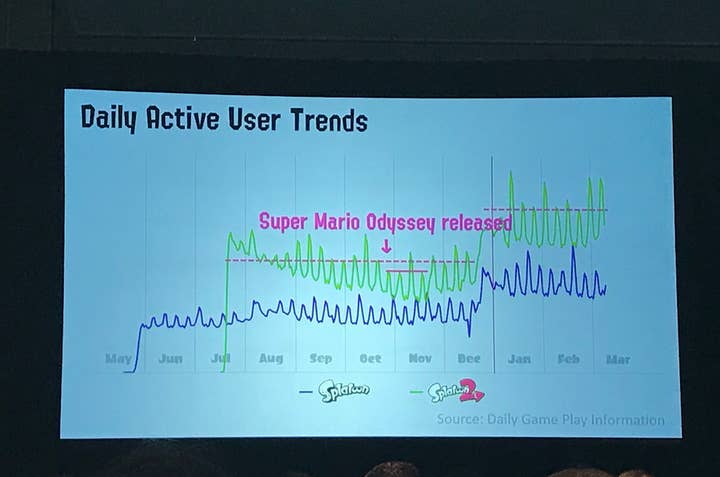Splatoon creator: “Fan art and live events are part of the world of the game”
How Nintendo's most recent super franchise was born
During the last main Nintendo Direct, the platform holder unveiled its big Switch game of the year - Super Smash Bros.
It revealed it with a teaser trailer starring two Splatoon characters firing paint at one another, before the world goes dark and the Smash Bros symbol burns in the sky. The Inklings will be joining Zelda, Pikachu, Mario, and all the other Nintendo icons in the firm's next beat 'em up.
It was the final confirmation of something that has, in reality, been long established. Splatoon is Nintendo's newest super franchise. It was one of the few genuine triumphs to emerge from the company's difficult Wii U era. The first game alone sold 4.91 million units - more than one third of the console's install base.
That was only three years ago. There's been 11 Amiibo toys, a guest appearance in Mario Kart and a full sequel in that time. Splatoon 2 for Switch has already matched its predecessor in terms of sales. In three years, the IP is sitting alongside the likes of Mario, Pokémon, Zelda and Animal Crossing as one of Nintendo's most important brands.
It's a remarkable achievement for a game that's just so very weird. And at GDC this week, producer Hisashi Nogami took to the stage to discuss the birth of the series.
"In early 2013, we formed a team of ten developers with the goal of making a new type of game that wouldn't fit easily into pre-existing categories," he said on stage. "We discussed our ideas together every day, until after half a year, we had 70 different design proposals and several software prototypes. Splatoon emerged from this process."

The game was to be a Nintendo-style action game, although the firm didn't go out specifically to create a shooter. The first prototype featured box characters - described internally as Tofu - spraying black or white ink on the ground to claim territory. This was the first prototype.
"It would use the language of shooters, but we didn't set out to make a shooter from the start," Nogami said."It would use the language of shooters, but we didn't set out to make a shooter from the start."
The firm would then implement the features of the Wii U Game Pad, specifically the second screen but also motion controls, to ensure the game felt fun.
Yet it isn't really the gameplay that makes Splatoon an unusual franchise, but rather the core characters. The Inklings are humanoids that shoot, but then turn into squids to swim through ink. It's such a bizarre concept, but the journey Nintendo took in developing those characters was based on sensible thinking.
"People are often surprised that our main character is a squid that can transform into a human," said Nogami. "But there are reasons why this happened and it wasn't without its twists and turns."
The firm initially toyed with utilising existing Nintendo characters, including the cast of Super Mario. But that was shortly abandoned as it didn't fit the style of game.

Then the team made the main characters look like rabbits. They felt this was a good fit as rabbits can be black and white, which made team distinction easy. They were also territorial creatures, so it matched the gameplay.
Yet over time the development team realised that the characters were flawed.
"Why would rabbits be shooting inks? Why would rabbits be able to submerge themselves in ink when they shot it? Something about that concept didn't fit right," Nogami says. "Our method for choosing our character wasn't fundamentally flawed, but there was a disconnect between our idea and how it actually played."

Certain elements didn't gel, so the studio looked at the abilities that the characters had. Including submersion in ink, and the need to fire weapons. This led to the creation of certain characters, including a human concept with a squid head. But it still didn't look right.
That was until they decided that the submersion in ink was effectively swimming, and that created a "strong reason" to go with squids. Only this time there would be two states - squids for the ink traversal and humanoid for the shooting element.
That was how the characters came to be. But as for the unique Splatoon world, with its music, art style and overall appearance, that came from a number of different influences.
"At this point, individual members of the team contributed ideas about what would fit the world well, and other features they felt passionate about," Nogami recounts. "From here the world of Splatoon took shape."
This was true of everything that built up the world - the fashion of the characters, the weapons and even the graffiti.
One such idea came from the sound team. They wanted to create music that the youth within Splatoon would listen to and developed fictional pop groups and songs that would add depth to the world.
"It was if we started like we built a big container, and we kept chucking balls into the container to see what the content would be," Nogami says. And this isn't specific to Splatoon, either. But a strategy that Nintendo often relies upon in creating games - new IP and established franchises.
Having created the characters and the world, the next step was dealing with the familiar challenge of launching a new online game, uncertain just how popular it would be.
Nintendo wanted to ensure players embraced the game for the long-term and also took their time in understanding the various mechanics in Splatoon. To do this, the developers launched Splatoon in quite a basic state - with just a handful of weapons, levels and modes. But the company regularly updated it with additional free content at a very regular pace.
"By adding new weapons, stages and modes as player familiarity increased, we hoped to keep the game fresh for players, and create an environment they wanted to engage in for longer," Nogami explains.
The approach worked. Nogami revealed the daily active user graph for Splatoon (and Splatoon 2), which showed that the game's popularity remained steady, with spikes occurring around special in-game events, content updates and the Christmas period.

When Nintendo came to developing Splatoon 2 there was uncertainty around how Switch was going to perform. Indeed, Nogami admitted that the developer was wary that their player base may shrink while Switch found itself an audience.
Having learnt from the first game, Nintendo brought back the idea of frequent updates, but also added new modes that fed into the wider Splatoon ecosystem.
"The single player campaign, which we call hero mode, acts as a training mode to new players who lack confidence in the controls before trying other modes," Nogami said.
"Playing through the campaign puts players through their paces, but also creates connection to the world. As we expected Splatoon 2 would have new players, we decided to give the mode the same sort of purpose.
"But we also wanted to offer a new attraction. That was Salmon Run, a game focused on co-operation."
The single-player mode acted as training on the basic moves and weapons of Splatoon. Salmon Run required proficiency in the controls and knowledge of all the various weapons. All of which fed into the main multiplayer battle mode.
"The three modes of single player, multiplayer, and Salmon Run, although created separately, were part of a single game concept," Nogami told attendees. "Rewards earned during Salmon Run and Hero mode could be used in multiplayer. and skills learned will be useful in each mode."
He continued: "It wasn't a game that you played to complete, but something you played as it evolved over time. Splatoon was envisioned as a set of experiences rather than a static piece of software."
The company is now adding paid DLC in the form of a new story mode, but this is only to add depth to the Splatoon world. Anything that impacts the core experience - weapons, maps etcetera - will remain free to ensure a level playing field.
"This isn't to say this style of roll out of content was planned from the beginning," said Nogami. "There are things we've done to react to feedback requests from the fans."
The paid DLC is just one way that Nintendo is bringing depth to the Splatoon series. The other is via real-world activity, which the developer is deeply involved in.
One such event is inspired by the popularity of the in-game characters the Squid Sisters, who acted as guides in the first Splatoon.
"They are a successful pop duo, and fans latched onto them more than we expected," he explained. "Fans have created fan art and even elaborate back stories for them. And taking a queue from that interest, the Squid Sisters have released new singles and even performed live."
The Squid Sisters concert features costumed characters dance and perform along to the music. The first event took place in Japan last month - featuring Splatoon 2's main characters Off The Hook - and attracted 5,000 attendees.
"It might seem strange, but as developers nothing can make us happier to see characters mean so much to people. It was like watching our kids grow up and succeed in the real world.
"As developers, we took care to review every last aspect of the concert, to make sure it reflected the game.
"I think of events taking place in association with the game, as an extension of the game in real life"
"So far, concerts like this have been held in Japan and France. And next week we'll do a concert in Switzerland. There's not one yet in the States, but the Squid Sisters is hoping an appealing offer comes along."
Nogami continues: "I think of events taking place in association with the game, as an extension of the game in real life. I enjoyed playing games as a kid, but my best memories are the excited conversations I had with friends about games.
"So in my mind, drawing fan art and going to game event, is part and parcel of enjoying the world of the game itself."
There are esports tournaments, too. Including one that attracted 877 teams and over 3,500 competitors in Japan. Splatoon has appeared at Nintendo World Championships, E3 and the Splatoon European championships has already visited 9 cities.
"There are also many grass roots tournaments formed around the world," Nogami continues. Who adds that the firm is honoured that pro-gamers believe the title is suitable for high level competitive play. "My hand still sweats a little seeing professional gamers playing the game."
Yet, he concludes. For all this depth, the heart of Splatoon reflects what Nintendo tries to do with all of its titles.
"Our goal is to enable people from all around the world to play," Nogami concluded. "Tournaments are opportunities for fans and the community to come together for a shared experience. And to show off the skills they've honed. We will do everything we can to support these events moving forward."
